Can You Grow A Garden On A Balcony
When designing a balcony garden, a limitation on space can mean it's hard to find inspiration and know where to begin. But in fact, with a little know-how and imagination, creating a balcony garden can be a truly rewarding experience. From the best plants based on aspect to maximising space, all the advice you need - from a trio of experts - is outlined in our bumper guide of balcony garden ideas.
But before you get started with the designing and planting, it's important to make a solid plan of action that takes into account important details about your balcony.
"I often go on Pinterest and look at examples just to get an idea what style I like," said Ula Maria, author of Green: Simple Ideas for Small Outdoor Spaces.
"Think about what size balcony you have, and whether it's shady or sunny, then write all of those things down, almost like a brief for yourself. Then look online for balconies that are similar. Find the ones that capture your imagination and look at how you can recreate that yourself."
Isabelle Palmer, author of Modern Container Gardening: How to Create a Stylish Small-Space Garden Anywhere feels its important to consider how you'll use your balcony.
"Designate how you want to use the space. Is it somewhere that you want to sit and relax? Is it a space that's quite difficult because either there's no sun or it's very exposed?. You can start zoning and deciding how you can use the space effectively."
Isabelle also feels it's key to recognise the features of the indoor space that the balcony leads off from, and how to link the two areas.
"Think about where the space is leading off from - a living room or a bedroom, and how that is going to affect your outdoor space. Have you got a colour scheme inside? Do you want to make that seamless flow from the living space into your balcony garden? Certain colours in a nice cushion or picture can give some hints and tips into your kind of colour scheme."
Balcony garden: Important points to consider
Sun and wind exposure
Many balconies can be without a roof or cover above, meaning they're very exposed to the elements including sun and wind. It's crucial you understand how much your balcony will be affected by such things, according to Alex Mitchell, author of The Edible Balcony: Growing Fresh Produce in the Heart of the City.
"Work out which way you're facing, spend time on the balcony and work out where the wind is coming from. Usually, you'll get wind mostly from one direction, and often in this country it's westerly although in a city you can get all sorts of air currents. I would recommend some kind of windbreak if you can – bamboo screening is great tied to railings with cable ties," Alex said.
"Or, you could plant something to create a bit of a windbreak. Lavender, for example, is happy in wind and will have that effect. Also, rosemary which very happy in wind, and it's evergreen.
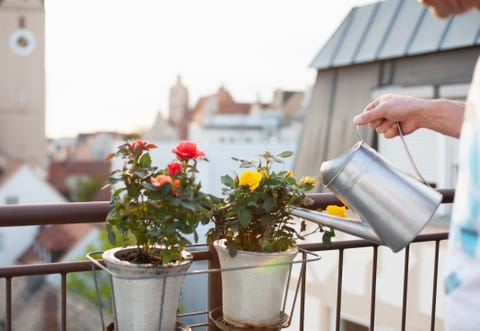
Kathrin Ziegler Getty Images
"If you do use pots, you can plant things a little lower and that means the sides of the pots act as a mini wind break and that's a good way to increase your production," she added.
Isabelle recommends a range of hardy plants for windy balconies.
"If you're quite exposed to wind you need to look at hardy plants, things with waxy leaves such as fatsia japonica - that's quite good when it's windy and there's sun exposure," she said.
She also recommends snapdragons, cosmos and jasmine.

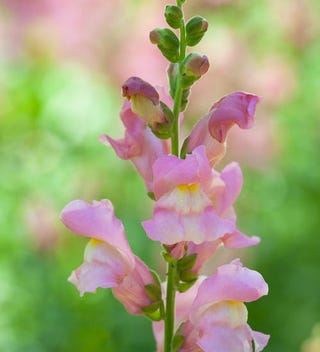
Antirrhinum majus 'Appleblossom'


Beautifully Fragrant White Jasmin Plant
FarmersOutlet etsy.com
US$12.00
"You want to steer away from very tall flowering plants, such as delphiniums because they're going to go crazy in the wind and obviously they're going to get a lot more sun exposure," Isabelle added.
"Another plant that grows happily in wind is samphire, which grows on beaches. You can grow it in a pot, you just need to add sea salt when you water it to recreate its natural environment. If it is very windy try to create as much shelter as you can," advised Alex.
Watering
Because of the sometimes harsher elements on balconies, and the fact that containers dry out quicker, you'll need to take care to ensure your watering routine is right.
"You're going to have to water quite a lot, especially if it's very sunny and exposed and windy. So, bear that in mind, either using water reservoirs in your pots, using an irrigation system, or making sure that you've got ready water supply to water your plants," Isabelle said.
"I would get the biggest container that you possibly can and that fits in this in your space. (Check what the weight capacity is on your balcony first). That means that you're not going to have to water as much and also I think having a bigger pot looks aesthetically more pleasing. Go for odd numbers - one, three or five, rather than having lots of different little pots. Keep the materials quite harmonious by using he same colour pots or materials.
"In the height of summer, you'd need to water at least once and probably twice a day in the morning and the evening, before the sun's come up and after it's gone down. Do it at the coolest time otherwise it just will completely evaporate as you're watering," Isabelle added.
Shade
Alternatively, some balconies can be prone to prolonged shade and in these cases, Isabelle recommends the likes of:
Ferns, ivies, fatsia, hydrangeas, delphiniums, lupins, foxgloves, snapdragons, pansies and other perennial bedding plants.
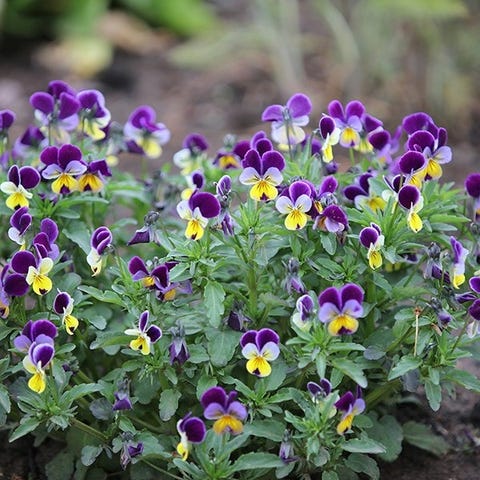
"Some vegetables do grow in shade. Most things you eat the leaves of will be relatively happy in shade. The things that won't like growing shade are things that produce fruit because they need sun in order to create sugar for the fruit. Shade wouldn't be so good for strawberries and tomatoes," advised Alex.
"Mint, coriander, sorrel are happy in shade. Also spinach and chard. Don't give up if you have just shade, you can still grow things," she added.
Weight
A vital consideration for balcony gardeners is the weight that their space can safely carry. This is something you should establish before any work begins.
"Make sure that you're not putting something incredibly heavy up there. Sometimes you might want to put a palm tree up but it's important to check whether the weight restrictions allow you to do that. The soil can get really heavy when it's watered. It's under-appreciated how heavy it can be," said Ula.
"Be aware of how heavy things are. If you have any doubt at all, be very careful and use light weight pots and carefully position your pots," said Alex.
"Work out where the supports are below you. If you have a balcony which is jutting out, then you're going to want to put your heaviest things near the house. But if you have a balcony which is on top of another balcony, sitting on top of walls, that's obviously going to be quite strong. Then you could put those heavy items towards the edge."
Alex recommends using light weight plastic Tubtrugs as planters and covering them over with natural-looking materials like bamboo.

Tubtrug Flexible Medium - blue
William Hunter Equestrian amazon.co.uk
£10.29
"I think they're really good for growing on balconies because they're light. If you're a bit nervous about weight, it's quite good to use Tubtrugs and then if you don't like the look of that you can wrap them in some reed screening you can buy on a roll. You can just cut that down and wrap it around any pot you don't like the look of to make it look more natural and blend in with the rest of your stuff," Alex said.
Designing your balcony garden
When it comes to design, Ula also feels it's important to make a balcony harmonious with the indoor space it's connected to.
"It's an extension of your home so I think the best thing is trying to provide that continuity from inside to the outside, to try and join those spaces and that will make the balcony space feel slightly more generous," she said.
For a cosy feel, Ula recommends soft furnishings, while bistro-style furniture that can be folded away easily gives flexibility for multi-functional space. She also says that mobile lights which can be recharged and moved around prolong the usage hours of a balcony.
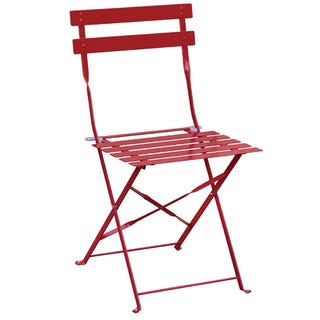
Bolero Red Pavement Style Steel Chairs (Pack of 2)

Norfolk Wooden Natural & black Bench
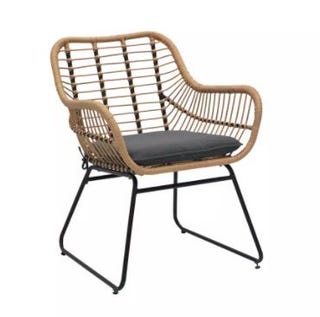
Argos Home Ross Rattan Effect Garden Chair
Argos Home argos.co.uk
£100.00
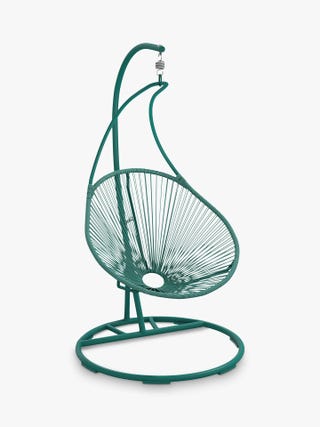
John Lewis & Partners Salsa Garden Hanging Seat, Agave
John Lewis johnlewis.com
£249.00
Planting vertically is a key way to maximise space.
"If there's a possibility of introducing planters vertically or hanging them on railings, do that rather than eating into the space of the balcony," Ula said.
It is possible to create different 'zones' on a balcony, too. This could mean different areas for eating, reading or relaxing, marked by certain plants or accessories.
"I recommend using larger pots and plants to create divisions on the balcony. If you've got a long, linear space, introducing large pots with large plants in them will create almost a series of smaller spaces," Ula said. This technique has another benefit, too.
"Placing larger objects within the space sometimes does help to give a feel of grandeur. I think one of the common mistakes is filling a small space with other tiny things that make everything feel very small. Sometimes the best thing is to invest in fewer plants and objects that make a real impact," she said.
You can also make a balcony feel more expansive using colour.

Galaxy Square Box Planter
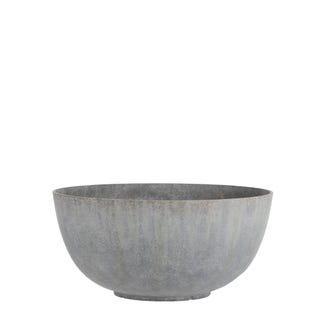

Peppermint Green Scalloped Botanical Planter
notonthehighstreet.com
US$14.00

"You really want to go with lighter colours. You want the lightest plants and furniture at the furthest viewpoints so that you elongate the space. Lighter colours at the end are going to draw the eye out and your space is going to be a bit bigger," explained Isabelle.
"Also I would only go for a small palette of colours. I never really go much more than three colours, not including green. I either pick three contrasting colours or three shades or tones of the same colour."
Is it possible to grow trees and shrubs?
"You can actually grow quite a lot of varieties in containers in terms of trees and specimen trees. It's just a case of a little bit more management," said Isabelle.
"You have to pot them on every two or three years to a big container, or failing that you can top dress, which is where you take off the top layer of soil and put some new compost on. You can do that after the second year as well to elongate that container."
Isabelle recommends the likes of acer, olive trees, eucalyptus, wisteria, clematis, fruit trees like apples.

Acer palmatum 'Wilson's Pink Dwarf'

Eucalyptus gunnii
thompson-morgan.com
£12.99

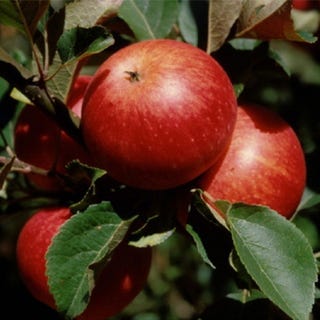
5ft 'Queen Cox' Dessert Apple Tree
Apple primrose.co.uk
£26.99
"Mexican orange blossom is a really nice big shrub which gives off a lovely scent of orange blossom and is very hardy and does well in in containers," she added.
Alex recommends growing fig or apple trees, if you want something larger.
"The great thing about them is they don't need such big pots as other fruit trees. You can get away with planting an apple tree in a pot that's about 45 centimetres in diameter at the top. (That's 40 to 60 litres). You get blossom, you get the fruit, you still get the structure over winter. They're very hardy and it's lovely to have some height in a balcony," Alex said.
Is it possible to grow succulents?
"They're seen as so easy as a houseplant because you don't have to water them but I think when you move outside that's when it gets a little trickier because ultimately they're desert plants and we have lots of rain here. So it's slightly different in terms of growing outside," Isabelle explained.
"The issue with succulents is that, come the winter months you have to bring them back in. They won't survive outside in the winter. Although, if you've got a very sheltered and south facing spot then possibly you can leave them out in the winter if it's sheltered from rain and severe wind."
How to plant for pollinators
"Butterflies and bees are really strongly attracted to purple plants - and yellows and reds but they're colours where you either love them or hate them terms of planting scheme so I'd always go purple. You've got things like verbena, salvia, lavender, ecinachea - they've got that wild flower look going on so I think that's the kind of road you need to go down," Isabelle said.
"There are some really great seeds where you can literally just pour them directly into a window box in about May and you'll get a complete window box full of wild flowers,"she added.
Isabelle also recommends lilacs, buddleias, dwarf sunflowers as well as herbs like chives.

Chive Seeds (Allium schoenoprasum), Perennial Herb Plants for planting Indoor and Garden, Grow your own Chive Plant: Herb Seeds for about 400 Chive Plants by OwnGrown
OwnGrown amazon.co.uk
£1.99
Growing edibles
While many people might think growing fruit and veg on a balcony would be too challenging, Alex feels it's very achievable if you use your imagination.
"It can be incredibly easy, it's really a question of just choosing the right crop that's suits growing in the container and there are loads that do. Some, like strawberries will actually grow in quite a shallow pot, like a window box or a hanging basket, so you can grow surprising things in quite small spaces like that," Alex said.
"There's only a few things that don't like growing in a pot - like raspberries - and you wouldn't want to grow big, big potatoes, because it would be a waste of space. But most other things are really quite suited to it. There's no limit to it really, it's really just a question of how much imagination you have."
Alex thinks growing the likes of tomatoes, beans and chillis is a great place to start.
"Tomatoes are brilliant in pots and they are really productive. I would always include growing tomatoes in a balcony. French beans and runner beans are great too and have lovely red flowers. French beans tend to be better in pots because they don't need so much water. If I have space, I'll add in a flower like nasturtiums to mix things up because everything's in your face, it's not like a veg patch at the edge of the garden. You want everything to be fragrant and pretty."

Tomato Plant - F1 Ponchi-Fa
Alex also recommends growing baby salad leaves.
"You can sow them from around early March, right up until October time. And if you want to try to take them through the winter, the great thing about growing in pots is that you can control the environment of it so much more easily than you can in the ground. So you could move it inside, you could leave it in a more sheltered part of your balcony or you could put a piece of glass on top of it which creates essentially a mini cold frame or mini greenhouse which means that the salad will grow all year. If you live in a city where things are generally a bit warmer, you can grow salad all year round," Alex said.
"If in doubt, imagine you're on the beach because a balcony's environment has similarities to the seaside – it's windy, it's exposed and it's often very sunny. Everything that grows by the coast would grow well on a balcony."
Another of her top tips is remembering to use your vertical space.
"Can you hang something up on the wall? Can you have a hanging basket? Could you build a vertical green wall? Could you put up some shelves then put lots of pots on there?
"If you have railings, make the most of them because you can have window boxes hanging on them and trailing down.
"Strawberries can be hassled by slugs so having them in a hanging basket is good because slugs can't get to them," she added.
When it comes to herbs, Alex recommends a wide variety.

Thyme Seeds Perennial
OwnGrown amazon.co.uk
£1.99
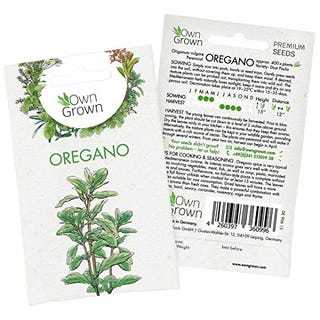
Oregano Seeds
OwnGrown amazon.co.uk
£1.99
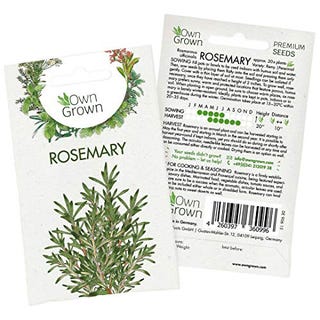
Rosemary Seeds Perennial
OwnGrown amazon.co.uk
£1.99
"For a sunny balcony, I would use terracotta pots for woody herbs – the kind you'd find in the Mediterranean that like sunny conditions including thyme and oregano and rosemary. And I would put those into medium sized pots with free draining soil," Alex said.
"I would do a window box of basil and chives, both of which like a rich soil so you could plant them in a peat-free compost. Lemon verbena is also a fabulous herb for a pot, or you could add blackcurrant sage which is a fabulous plant – rub the leaves and it smells of blackcurrant."
Clearly, the sky's the limit.
"If you imagine the tiniest balcony you could, just know it's possible to grow a lot there, and a fantastic array of things," Alex said.
Happy balcony gardening!
Like this article? Sign up to our newsletter to get more articles like this delivered straight to your inbox.
SIGN UP
Love what you're reading? Enjoy Good Housekeeping magazine delivered straight to your door every month with Free UK delivery. Subscribe now to save on the shop price + get instant digital access to the latest issue!
SUBSCRIBE
This content is created and maintained by a third party, and imported onto this page to help users provide their email addresses. You may be able to find more information about this and similar content at piano.io
Can You Grow A Garden On A Balcony
Source: https://www.goodhousekeeping.com/uk/house-and-home/gardening-advice/a35632249/balcony-garden/
Posted by: dotyandre1985.blogspot.com

0 Response to "Can You Grow A Garden On A Balcony"
Post a Comment